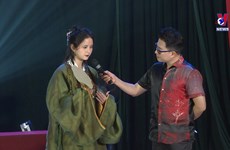Buddhism in Vietnamese people's spiritual lives
Visiting a pagoda and worship in pagoda were never before of my interest, confided Tran Lan Anh, an employee of a privately-run company in Hanoi. It has changed.
“I got accustomed to worshipping at pagodas with my mother in law,” the 35-year-old Hanoian said, elaborating that she now visits the Tran Quoc pagoda, perhaps the most ancient pagoda in Vietnam, on every first and fifteenth day of the lunar months.
“Now, when an occasion comes around, I bring flowers, fruits and joss sticks for the Buddha to pray for peace and happiness for my family,” she said.
Unlike Anh, many Vietnamese people do not visit pagodas on a regular basis but still take refuge in the Buddha, the Dharma and in the Sangha.
For them, and Buddhist followers alike, burning incense dedicated to the Buddha and praying for peace are common practices.
Only when visiting a pagoda, can one feel peace and tranquility, free from the hustle and bustle of everyday life, in the rising smoke of burnt joss sticks and the chanting of the Dharma by worshippers, monks and nuns.
Holding on a belief grown strongly among Buddhist followers, many month-old babies are “sold symbolically” to pagodas so that they can be given strength by Lord Buddha for an easier upbringing.
And, many families have placed the images of their deceased members at pagodas, to keep the souls of those beloved from feeling lonely and isolated.
Those activities have indicated lively how Buddhism was encompassed into the way Vietnamese people think and live, making a deep impression on Vietnamese culture.
Until the Ly dynasty (1009-1224), and later, the Tran dynasty (1225-1400), Buddhism flourished wealthily and has now become the dominant religion in Vietnam. The country currently has around 45 million Buddhist followers, 45,000 monks and nuns, and 14,775 pagodas, monasteries and temples nationwide.
In 1981, the Vietnam Buddhist Sangha brought together nine sects, becoming a strong organisation and contributing to national unification by adopting the mantra Buddhism – Nation – Socialism.
Buddhism and traditional spiritual beliefs are closely linked together and co-exist peacefully as evidenced by the Vietnamese’s worship of deities at shrines and the Mother Goddess at temples.
The four most worshipped deities at pagodas represent the weather Gods of Cloud, Rain, Thunder and Lightning, cast in the style of a statue of Buddha. It is according to each pagoda that a Deity or the Mother Goddess is worshipped in the back hall of the pagoda structure. The Buddha is always worshipped in the front hall of the pagoda. The Vietnamese also often bring deified emperors, Gods, Saints, Goddesses, villages’ guardians, the God of Land and national heroes to pagodas to worship.
Vietnamese Buddhism comprises of three main sects, namely Zen, Pure Land and Tantra, explained Most Venerable Thich Minh Thanh, Head of the 2,000 year- old Thang Nghiem Pagoda, which is located in Cu Khe commune, 15km south of central Hanoi, and where three national masters during the feudal period were brought up and national hero Tran Quoc Tuan (1232-1300) lived until he was 13 years old.
Pure Land is a kind of meditation mainly based on the power of Buddha while reciting Sukhavati Vyuha Sutra. It is easy to practice but difficult to believe and understand. The Zen sect focuses on creating an untroubled mind, removing all bad thoughts and praying with the aim of ‘beholding Buddhism and attaining enlightenment’, or using the mind to change mind. Meanwhile, Tantra focuses on chanting, to ward off evil spirits to attain enlightenment.
Since entering Vietnam, these sects have developed in their own ways. For example, Tantra is divided into India’s Tibetan Tantra and Vietnam’s Kriya Tantra, despite a lot of differences in the ways of reaching enlightenment. Another example is the famous Truc Lam Zen sect, founded by Buddhist King Tran Nhan Trong (1258-1308) which has left a lasting mark on Vietnamese philosophy.
For Buddhism to grow strongly, the most important factor is the role played by monks, said Most Venerable Thich Minh Thanh.
“It is necessary for monks to keep a pure mind, look for tranquility, never be afraid of poverty and avoid luxuries, not only in material terms but more importantly, in the mind,” the Most Venerable said.
To follow that, the quiet Thang Nghiem Pagoda under the management by Most Venerable Thich Minh Thanh, holds Dharma lectures every Saturday to teach villagers how to act in the right, proper ways.
Apart from that, through such social activities as providing treatment of diseases using traditional medicines, Thang Nghiem has become an integralpart of the life of Cu Khe residents, like other pagodas in rural Vietnam.-VNA













